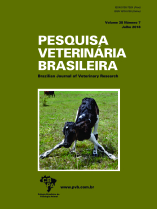 |
|
|
|
Year 2018 - Volume 38, Number 7
|

|
Description and post-operative evaluation of tie-in technique in tibial osteosynthesis in dogs, 38(7):1376-1381
|
ABSTRACT.- Dias L.G.G.G., Padilha Filho J.G., Conceição M.E.B.A.M., Dias F.G.G. & Barbosa V.T. 2018. Description and post-operative evaluation of tie-in technique in tibial osteosynthesis in dogs. [Descrição e avaliação pós-operatória de técnica de osteossíntese com tie-in em tíbia.] Pesquisa Veterinária Brasileira 38(7):1376-1381. Setor de Cirurgia Veterinária, Departamento de Clínica e Cirurgia Animal, Faculdade de Ciências Agrárias e Veterinárias, Universidade Estadual Paulista “Julio de Mesquita Filho”, Campus de Jaboticabal, Via de Acesso Prof. Paulo Donato Castellane s/n, Jaboticabal, SP 14884-900, Brazil. E-mail: gustavogosuen@fcav.unesp.br
The aim of this study was to describe and analyse the adaptability and functionality of tie-in configuration in tibial osteosynthesis in dogs. Twenty dogs with tibial fracture were included in this study. An orifice was made on the proximal tibial fragment, on the medial side, close to the tibial crest. The drill piece was angled at 45º and projected into the same orifice on the distal sense of the bone. Others orifices made with the aid of a low rotation drill and drill piece with diameter smaller than the chosen implant. After 10 days post‑operative, the animals were evaluated. X-ray analysis was performed at the time of clinical examination; immediate post-operative period; and at 30, 60, 90, and 120 days post-surgery. A questionnaire was given to the owners to provide details on the post-operative period. There were no trans-operative complications or suture dehiscence up to the day of suture removal. Partial development of bone callus was observed in 20 dogs within a mean period of 76 days. Three animals showed bone consolidation within 35 days, nine by 60 days, three by 90 days, and 5 by 120 days post-operative. Dynamization was carried out in 9 animals. The surgical access to the tibial medullary canal through the orifice at the proximal medial face, by the tibial tuberosity, enables the insertion of IMP without risks to articular and peri-articular lesions in the knee in dogs. |
| |
|
|
| |
|
 |